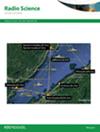多静态镜面流星雷达观测到的 2022 年 Hunga Tonga-Hunga Ha'apai 火山喷发造成的中间层和低温层风扰动
IF 1.6
4区 地球科学
Q3 ASTRONOMY & ASTROPHYSICS
引用次数: 0
摘要
本研究利用多静态镜面流星雷达(MSMR)观测数据,深入研究了 2022 年洪加汤加-洪加哈帕伊(HTHH)海底火山史无前例的喷发对中间层和低温层(MLT)风扰动的全球影响。结合南美洲和欧洲上空不同观测角度的 MSMR 观测数据,并将水平风分解为 HTHH 火山喷发震中方向沿线和横向的分量,可以明确探测和识别与火山喷发有关的 MLT 扰动。利用热层/电离层扩展的全大气层群气候模式(WACCM-X)对该事件进行了模拟,评估了这种分解方法的性能。结果表明,HTHH 火山喷发信号确实被清晰地识别出来,而其他信号则很容易被剔除。在这种分解中,风以 242 米/秒的速度向东传播,在距离 HTHH 25,000 公里处观测到了主要的孤子状扰动。仅在欧洲上空观测到的一个较弱的扰动以每秒 300 米的速度向西传播。这些结果表明,我们观测到的可能是所谓的 Pekeris 模式,它也与 L1 伪模式一致,由 WACCM-X 模拟在 MLT 高度再现。它们还排除了之前将南美洲的观测结果与喷发引起的海啸联系起来的假设,因为在欧洲上空也观测到了这些扰动。尽管取得了进展,但 WACCM-X 在 MLT 中再现的 L0 伪模式仍然难以观测到。本文章由计算机程序翻译,如有差异,请以英文原文为准。
Mesosphere and lower thermosphere wind perturbations due to the 2022 Hunga Tonga-Hunga Ha'apai eruption as observed by multistatic specular meteor radars
Utilizing multistatic specular meteor radar (MSMR) observations, this study delves into global aspects of wind perturbations in the mesosphere and lower thermosphere (MLT) from the unprecedented 2022 eruption of the Hunga Tonga-Hunga Ha'apai (HTHH) submarine volcano. The combination of MSMR observations from different viewing angles over South America and Europe, and the decomposition of the horizontal wind in components along and transversal to the HTHH eruption's epicenter direction allow an unambiguous detection and identification of MLT perturbations related to the eruption. The performance of this decomposition is evaluated using Whole Atmosphere Community Climate Model with thermosphere/ ionosphere extension (WACCM-X) simulations of the event. The approach shows that indeed the HTHH eruption signals are clearly identified, and other signals can be easily discarded. The winds in this decomposition display dominant Eastward soliton-like perturbations observed as far as 25,000 km from HTHH, and propagating at 242 m/s. A weaker perturbation observed only over Europe propagates faster (but slower than 300 m/s) in the Westward direction. These results suggest that we might be observing the so-called Pekeris mode, also consistent with the L
1
pseudomode, reproduced by WACCM-X simulations at MLT altitudes. They also rule out the previous hypothesis connecting the observations in South America to the Tsunami associated with the eruption because these perturbations are observed over Europe as well. Despite the progress, the L
0
pseudomode in the MLT reproduced by WACCM-X remains elusive to observations.
求助全文
通过发布文献求助,成功后即可免费获取论文全文。
去求助
来源期刊

Radio Science
工程技术-地球化学与地球物理
CiteScore
3.30
自引率
12.50%
发文量
112
审稿时长
1 months
期刊介绍:
Radio Science (RDS) publishes original scientific contributions on radio-frequency electromagnetic-propagation and its applications. Contributions covering measurement, modelling, prediction and forecasting techniques pertinent to fields and waves - including antennas, signals and systems, the terrestrial and space environment and radio propagation problems in radio astronomy - are welcome. Contributions may address propagation through, interaction with, and remote sensing of structures, geophysical media, plasmas, and materials, as well as the application of radio frequency electromagnetic techniques to remote sensing of the Earth and other bodies in the solar system.
 求助内容:
求助内容: 应助结果提醒方式:
应助结果提醒方式:


